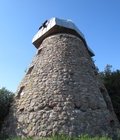The mill was built between the end of the 19th century and the beginning of the 20th century. The first owner of the mill was Kazimieras Bočiulis. After his death, his wife moved to America, his son Petras went to serve (in order to earn money), and the mill was leased to Domas Žiukas from Kupiškis. According to another version of this story, Peter was too young and therefore the mill was rented out. However, the mill stuck in the memory of Kupiškis residents precisely as the mill of Petras Bočiulis. Wheat, rye, oat, barley and pea flour were ground, but no groats were produced in the mill. According to contemporaries, the mill could work only on windy days. It gave little profit, because there were 7 other mills in the town. Others remember that it rarely worked because the old master had no children and was no longer able to grind alone. Eventually, the mill mechanisms themselves were completely worn out. The mill stopped working in 1941. Bočiuliai family began to use the mill as a barn. It was also used as a kitchen, as a result, smoke damaged the stones of the mill's walls. During the Soviet Era, the mill belonged to Kupiškis district cooperative (distrcit union). It became a warehouse for furs and animal skins. The mill was partially restored in 1990. Currently, the mill is a private property. It was included in the Register of Cultural Property in 1992, and it was recognized as protected by the state in 2005.

+1










Reviews